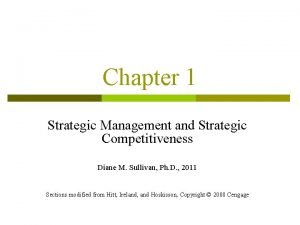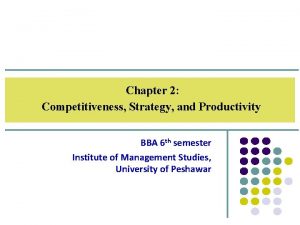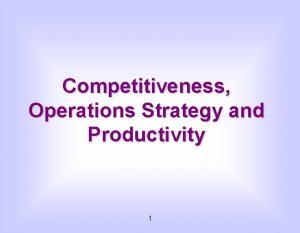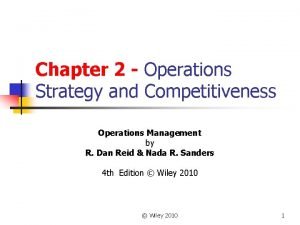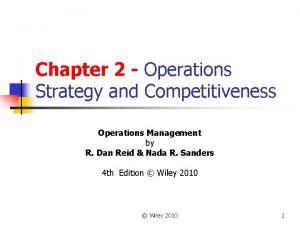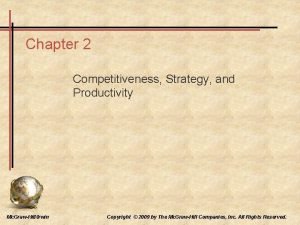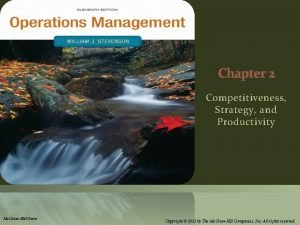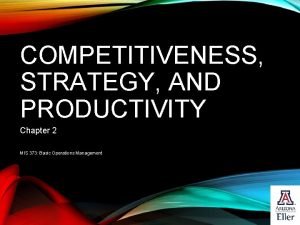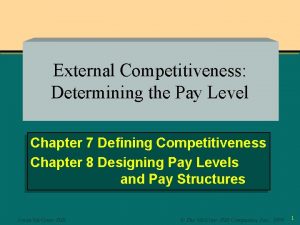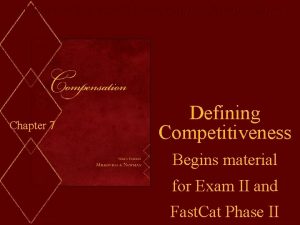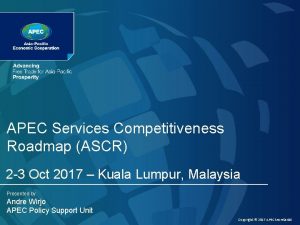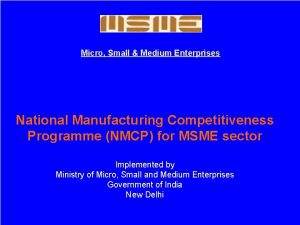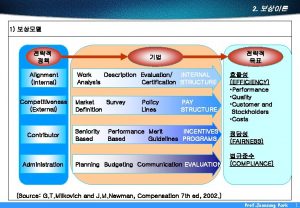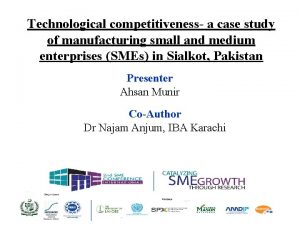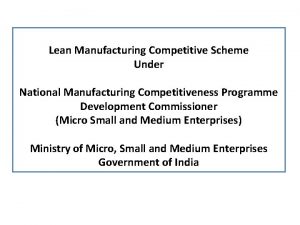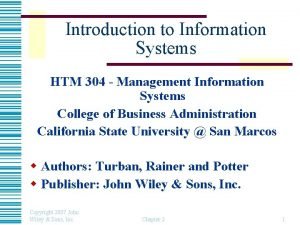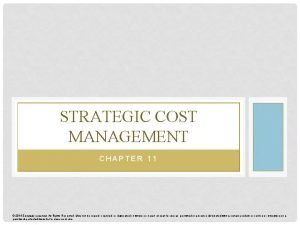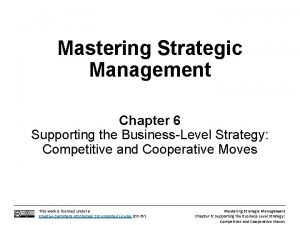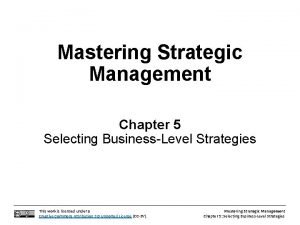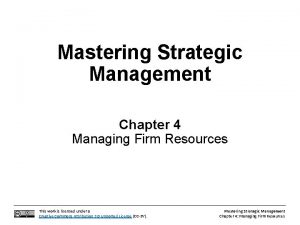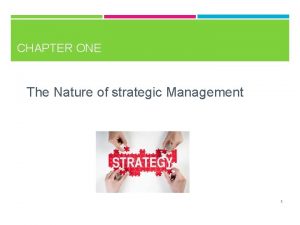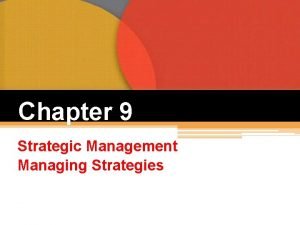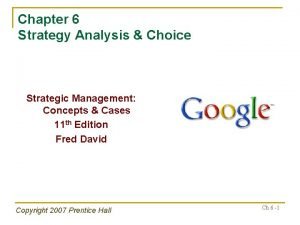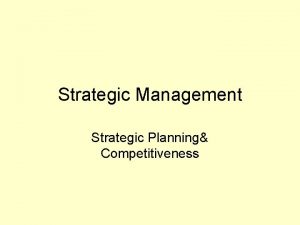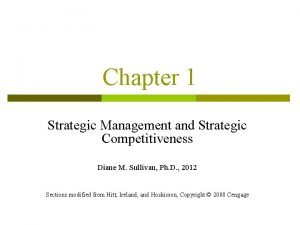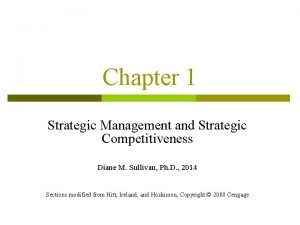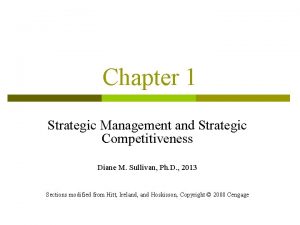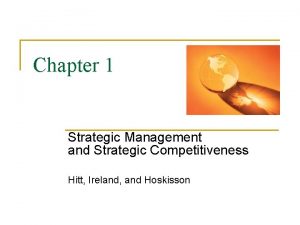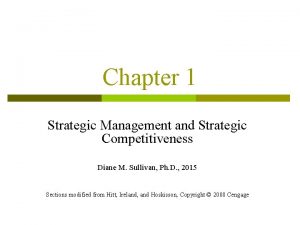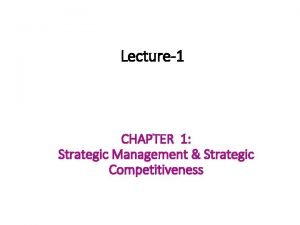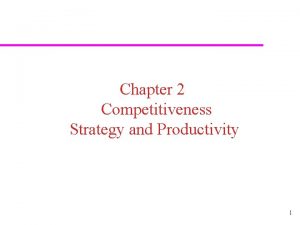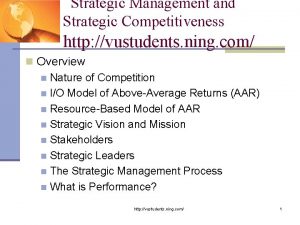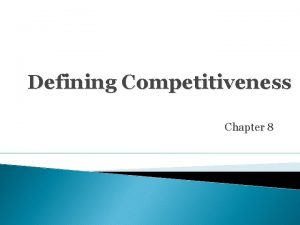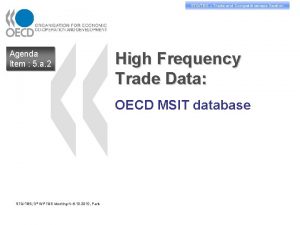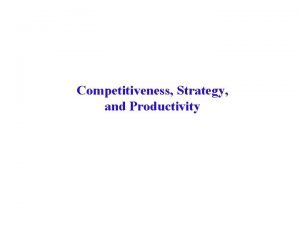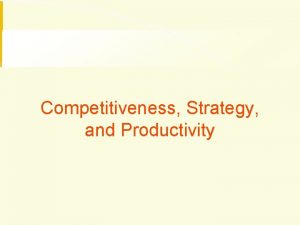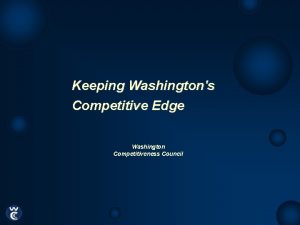Chapter 1 Strategic Management and Strategic Competitiveness Michael
































- Slides: 32

Chapter 1 Strategic Management and Strategic Competitiveness Michael A. Hitt R. Duane Ireland Robert E. Hoskisson © 2000 South-Western College Publishing Ch 1 -1

Strategic Competitiveness Achieved when a firm successfully formulates and implements a value-creating strategy Sustained Competitive Advantage Occurs when a firm develops a strategy that competitors are not simultaneously implementing Provides benefits which current and potential competitors are unable to duplicate Above-Average Returns in excess of what an investor expects to earn from other investments with similar risk Ch 1 -2

The Strategic Management Process Involves the full set of: Commitments Decisions Actions which are required for firms to achieve: Strategic Competitiveness Sustained Competitive Advantage Above-Average Returns Ch 1 -3

Strategic Inputs Chapter 2 External Environment Strategic Intent Strategic Mission Chapter 3 Internal Environment Strategic Outcomes Strategic Actions Strategy Formulation The Strategic Management Process Strategy Implementation Chapter 4 Business-Level Strategy Chapter 5 Competitive Dynamics Chapter 6 Corporate-Level Strategy Chapter 10 Corporate Governance Chapter 11 Structure & Control Chapter 7 Acquisitions & Restructuring Chapter 8 International Strategy Chapter 9 Cooperative Strategies Chapter 12 Strategic Leadership Chapter 13 Feedback Entrepreneurship & Innovation Strategic Competitiveness Above Average Returns Ch 1 -4

Chapter One: Key Themes Challenge of Strategic Management Changing Competitive Landscape Two Models of Superior Profitability • Industrial Organization Model • Resource-Based Model Key Stakeholder Groups Ch 1 -5

Challenge of Strategic Management Only 16 of the 100 largest U. S. companies at the start of the 20 th century are still identifiable today! In a recent year, 44, 367 businesses filed for bankruptcy and many more U. S. businesses failed Competitive success is transient. . . unless care is taken to preserve competitive position Ch 1 -6

Challenge of Strategic Management Best Stocks of the Decade The goals of achieving strategic competitiveness and earning aboveaverage returns are challenging The performance of some companies more than meets strategic management's challenge Ch 1 -7

21 st Century Competitive Landscape Fundamental nature of competition is changing • Rapid technological changes • Rapid technology diffusions • Dramatic changes in information and communication technologies • Increasing importance of knowledge The pace of change is relentless. . and increasing Traditional industry boundaries are blurring, such as. . . • Computers • Telecommunications Ch 1 -8

21 st Century Competitive Landscape The global economy is changing • People, goods, services and ideas move freely across geographic boundaries • New opportunities emerge in multiple global markets • Markets and industries become more internationalized Traditional sources of competitive advantage no longer guarantee success New keys to success include: • • Flexibility Innovation Speed Integration Ch 1 -9

21 st Century Competitive Landscape A country’s competitiveness is achieved through the accumulation of individual firms’ strategic competitiveness in the global economy Achieving improved competitiveness allows a country's citizens to have a higher standard of living Country Competitiveness Rankings

Alternative Models of Superior Returns Industrial Organization Model Resource-Based Model The External Environment Resources An Attractive Industry Capability Strategy Formulation Competitive Advantage Assets and Skills An Attractive Industry Strategy Implementation Superior Returns Ch 1 -11

I/O Model of Superior Returns The Industrial Organization model suggests that above-average returns for any firm are largely determined by characteristics outside the firm. This model largely focuses on industry structure or attractiveness of the external environment rather than internal characteristics of the firm. Ch 1 -12

I/O Model of Superior Returns External Environment General Environment Industry Environment Competitive Environment Action required: Study the external environment, especially the industry environment. Ch 1 -13

I/O Model of Superior Returns External Environment An Attractive General. Industry Environment An industry whose Competitive structural characteristics Environment suggest above-average returns are possible Action required: Locate an industry with high potential for aboveaverage returns. Ch 1 -14

I/O Model of Superior Returns External Environment Attractive General. Industry Environment Strategy An industry whose Formulation Competitive structural characteristics Action required: Identify strategy called for by the industry to earn above-average returns. Environment Selection of a strategy suggest above-average with abovereturns are linked possible average returns in a particular industry Ch 1 -15

I/O Model of Superior Returns Action required: External Develop or acquire assets Environment Attractive and skills needed to General. Industry Environment implement the strategy. Strategy Industry Environment An industry whose Formulation Competitive structural characteristics Environment and Skills Selection of. Assets a strategy suggest above-average with abovereturns arelinked possible Assetsinand average returns a skills required to implement particular industry a chosen strategy Ch 1 -16

I/O Model of Superior Returns Action required: External Use the firm’s strengths Environment Attractive (its assets or skills) to General. Industry Environment implement the strategy. Strategy Industry Environment An industry whose Formulation Competitive structural characteristics Environment and Skills Selection of. Assets a strategy suggest above-average with abovereturns arelinked possible Assetsinand skills average returns a Strategy required to implement Implementation particular industry a chosen strategy Selection of strategic actions linked with effective implementation of the chosen strategy Ch 1 -17

I/O Model of Superior Returns Action required: External Maintain selected strategy Environment Attractive in order to outperform General. Industry Environment industry rivals. Strategy Industry Environment An industry whose Formulation Competitive structural characteristics Environment and Skills Selection of. Assets a strategy suggest above-average with abovereturns arelinked possible Assetsinand skills average returns a Strategy required to implement Implementation particular industry Superior Returns a chosen strategy Selection of strategic actions linked with Earning of aboveeffective implementation average returns of the chosen strategy Ch 1 -18

Resource-Based Model of Superior Returns The Resource-Based model suggests that above-average returns for any firm are largely determined by characteristics inside the firm. This model focuses on developing or obtaining valuable resources and capabilities which are difficult or impossible for rivals to imitate. Ch 1 -19

Resource-Based Model of Superior Returns Resources Inputs to a firm’s production process. Action required: Identify firm resources. Study strengths and weaknesses relative to rivals. Ch 1 -20

Resource-Based Model of Superior Returns Resources Capability Inputs to a firm’s production process. Capacity for an integrated set of resources to perform a task or activity. Action required: Determine what firm capabilities allow it to do better than rivals. Ch 1 -21

Resource-Based Model of Superior Returns Resources Capability Inputs to a firm’s Competitive production process. Capacity for an integrated set of resources to Advantage integratively perform a Ability of a firm to task or activity. outperform its rivals Action required: Determine how firm’s resources and capabilities may create competitive advantage. Ch 1 -22

Resource-Based Model of Superior Returns Resources Capability Action required: Locate an attractive industry. Inputs to a firm’s Competitive production process. Capacity for an integrated set of resources to Advantage integratively perform An a Attractive Ability of a. Industry firm to task or activity. outperform its rivals Location of an industry with opportunities that can be exploited by the firm’s resources and capabilities Ch 1 -23

Resource-Based Model of Superior Returns Resources Capability Action required: Select strategy that best exploits resources and capabilities relative to opportunities in environs. Inputs to a firm’s Competitive production process. Capacity for an integrated set of resources to Advantage integratively perform An a Attractive Ability of a. Industry firm to task or activity. outperform its rivals. Strategy Location of an industry Formulation with opportunities that and can be exploited by the Implementation firm’s resources and Strategic actions taken to capabilities earn above-average returns Ch 1 -24

Resource-Based Model of Superior Returns Resources Capability Action required: Maintain selected strategy in order to outperform industry rivals. Inputs to a firm’s Competitive production process. Capacity for an integrated set of resources to Advantage integratively perform An a Attractive Ability of a. Industry firm to task or activity. outperform its rivals. Strategy Location of an industry Formulation with opportunities that and Superior Returns can be exploited by the Implementation firm’s resources and Strategic actions taken to Earning of abovecapabilities earn above-average returns Ch 1 -25

Resources and capabilities lead to Competitive Advantage when they are: Valuable allow the firm to exploit opportunities or neutralize threats in its external environment Rare possessed by few, if any, current and potential competitors Costly to Imitate when other firms either cannot obtain them or must obtain them at a much higher cost Nonsubstitutable the firm must be organized appropriately to obtain the full benefits of the resources in order to realize a competitive advantage Ch 1 -26

When these four criteria are met, Resources and Capabilities become: Core Competencies are resources and capabilities that can serve as a source of Competitive Advantage. The Resource-Based model argues that Core Competencies are the basis for a firm’s Competitive Advantage, Strategic Competitiveness and Ability to Earn Above-average Returns. Ch 1 -27

Strategic Intent Winning competitive battles through deciding how to leverage internal resources, capabilities, and core competencies. Strategic Mission An application of strategic intent in terms of products to be offered and markets to be served. Ch 1 -28

Strategic Intent The most effective strategists provide a vision (strategic intent) to effectively elicit the help of others in creating a firm's competitive advantage. Ch 1 -29

Stakeholders: Groups who are affected by a firm’s performance and who have claims on its wealth The firm must maintain performance at an adequate level in order to maintain the participation of key stakeholders Firm Product Market Primary Customers Suppliers Capital Market Stock market/Investors Debt suppliers/Banks Organizational Employees Managers Non-Managers Ch 1 -30

Stakeholder Involvement Each of the key stakeholders wants a piece of the same pie 1 How do you divide the pie in order to keep all of the stakeholders involved? 2 How do you increase the size of the pie so that there is more to go around? Ch 1 -31

Strategic Inputs Chapter 2 External Environment Strategic Intent Strategic Mission Chapter 3 Internal Environment Strategy Implementation Chapter 4 Business-Level Strategy Chapter 5 Competitive Dynamics Chapter 6 Corporate-Level Strategy Chapter 10 Corporate Governance Chapter 11 Structure & Control Chapter 7 Acquisitions & Restructuring Chapter 8 International Strategy Chapter 9 Cooperative Strategies Chapter 12 Strategic Leadership Chapter 13 Outcomes Strategic Actions Strategy Formulation The Strategic Management Process Feedback Entrepreneurship & Innovation Strategic Competitiveness Above Average Returns Ch 1 -32
 Strategic management and strategic competitiveness
Strategic management and strategic competitiveness What is strategic competitiveness
What is strategic competitiveness Strategic competitiveness
Strategic competitiveness Competitiveness strategy
Competitiveness strategy Operations strategy and competitiveness
Operations strategy and competitiveness Productivity and competitiveness in operations management
Productivity and competitiveness in operations management Chapter 2 operations strategy and competitiveness
Chapter 2 operations strategy and competitiveness Competitive operations strategy
Competitive operations strategy The methods and actions taken to accomplish strategies
The methods and actions taken to accomplish strategies Tows matrix
Tows matrix Operations strategy and competitiveness
Operations strategy and competitiveness Competitiveness strategy and productivity
Competitiveness strategy and productivity Competitiveness, strategy and productivity
Competitiveness, strategy and productivity What is external competitiveness
What is external competitiveness Pay mix policy alternatives
Pay mix policy alternatives Apec services competitiveness roadmap
Apec services competitiveness roadmap National manufacturing competitiveness programme
National manufacturing competitiveness programme Internal competitiveness
Internal competitiveness Technological competitiveness
Technological competitiveness Lean manufacturing competitiveness scheme
Lean manufacturing competitiveness scheme The best-known framework for analyzing competitiveness is
The best-known framework for analyzing competitiveness is Defining competitiveness
Defining competitiveness Strategic substitutes
Strategic substitutes Process of strategic cost management
Process of strategic cost management Strategic management chapter 6
Strategic management chapter 6 Strategic management chapter 5
Strategic management chapter 5 Strategic management chapter 4
Strategic management chapter 4 Strategic management nature
Strategic management nature Strategic management chapter 9
Strategic management chapter 9 Chapter 7 strategic management
Chapter 7 strategic management Implementing strategies management and operations issues
Implementing strategies management and operations issues Implementing strategies: management and operations issues
Implementing strategies: management and operations issues Chapter 6 strategy analysis and choice
Chapter 6 strategy analysis and choice

